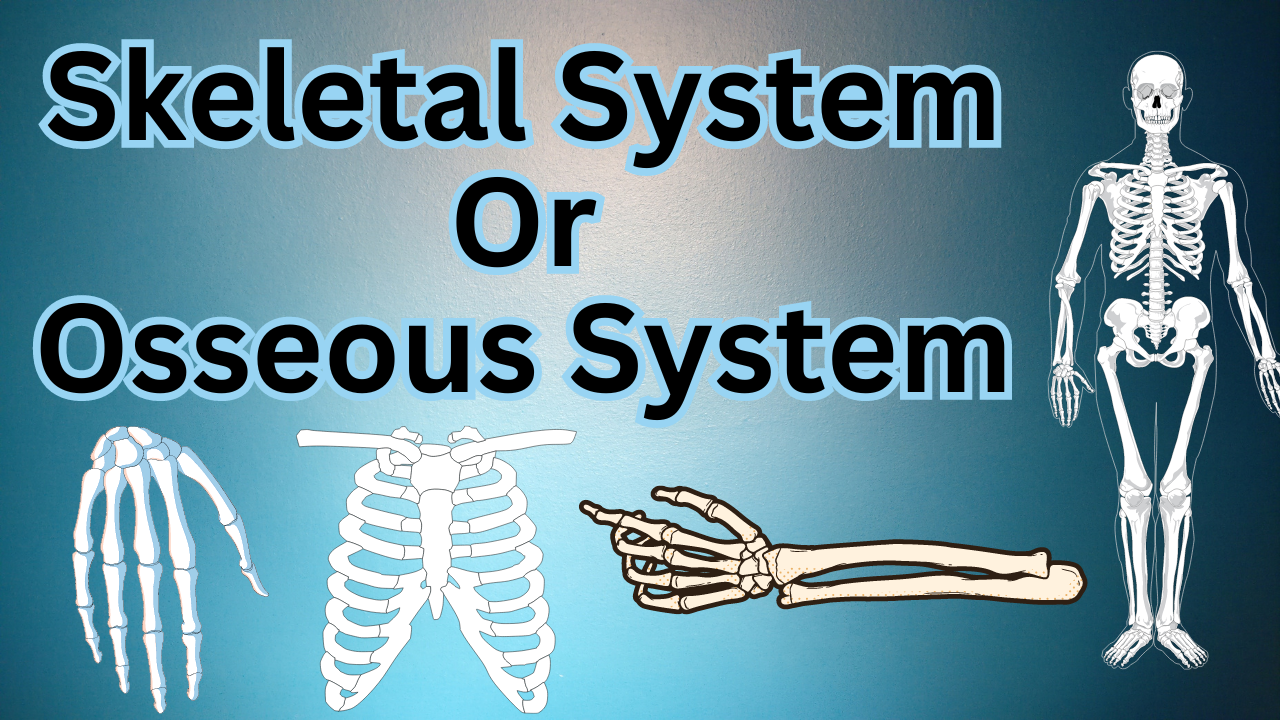Skeletal System Or Osseous System
The osseous system, also known as the skeletal system, forms the foundation of the human body. It provides structural support, protection to vital organs, enables movement, produces blood cells, and stores essential minerals. Consisting of 206 bones in adults, the skeletal system is a dynamic structure that interacts closely with the muscular and nervous systems. Understanding its intricate design and functions is crucial in the field of human anatomy and physiology.
This post will delve into the components, types of bones, functions, diseases, and disorders of the skeletal system, along with its role in the overall physiology of the human body.
Components of the Osseous System
The skeletal system comprises various elements that work together to provide the body with structure and function. These components include:
- Bones
- Cartilage
- Joints
- Ligaments
1. Bones
Bones are the primary structural component of the osseous system. They are rigid organs made of bone tissue and other connective tissues. The human skeleton contains 206 bones, which are classified into various categories based on their shapes and functions.
- Compact Bone: Dense and strong, forming the outer layer of bones, providing protection and strength.
- Spongy Bone: Less dense, found inside bones, especially in areas subjected to stress. Spongy bone is lighter and helps in shock absorption.
2. Cartilage
Cartilage is a flexible connective tissue that provides cushioning in joints and flexibility in certain parts of the body. It’s crucial for the smooth movement of joints and is found in areas like the nose, ears, and trachea.
3. Joints
Joints are where two or more bones meet and allow for movement and flexibility. They are categorized based on their range of motion and include:
- Immovable Joints: Found in the skull.
- Partially Movable Joints: Found in the vertebrae.
- Freely Movable Joints: Found in the limbs.
4. Ligaments
Ligaments are strong bands of connective tissue that connect bones to other bones at joints. They provide stability to the skeleton while allowing movement.
Types of Bones
Bones are classified into five different types based on their shapes. Each type serves specific functions that contribute to the overall mobility, protection, and strength of the body.
1. Long Bones
- Location: Found in the limbs (arms and legs).
- Examples: Femur, tibia, humerus.
- Function: Provide strength, structure, and mobility. These bones have a long shaft and are designed to support weight and facilitate movement.
2. Short Bones
- Location: Found in the wrists and ankles.
- Examples: Carpals, tarsals.
- Function: Provide support and stability with limited movement. These bones are as wide as they are long, contributing to the flexibility and strength of the joints.
3. Flat Bones
- Location: Found in the skull, ribs, and sternum.
- Examples: Frontal bone, parietal bone, scapula.
- Function: Protect vital organs and provide areas for muscle attachment. Flat bones have a broad surface that shields sensitive organs like the brain, heart, and lungs.
4. Irregular Bones
- Location: Found in the vertebrae and pelvis.
- Examples: Vertebrae, sacrum.
- Function: Protect nervous tissue and support the body’s weight. These bones have complex shapes that fit their specialized roles in the body.
5. Sesamoid Bones
- Location: Found embedded in tendons.
- Examples: Patella (kneecap).
- Function: Protect tendons from wear and tear. These bones are small, rounded, and typically located where tendons pass over joints.
Functions of the Skeletal System
The skeletal system plays a variety of critical roles in maintaining the body’s structure and health. These functions can be categorized as follows:
1. Support
The skeletal system provides a rigid framework that supports the body, allowing it to maintain shape and posture. Without the bones, the body would be unable to stand upright or maintain its form.
2. Protection
Bones protect vital organs from injury. For example:
- The skull protects the brain.
- The rib cage shields the heart and lungs.
- The vertebral column protects the spinal cord.
3. Movement
Bones work in tandem with muscles to facilitate movement. Muscles are attached to bones via tendons, and when muscles contract, they pull on bones to create motion. Joints play a key role in providing flexibility and range of motion.
4. Mineral Storage
Bones act as a reservoir for essential minerals, particularly calcium and phosphorus. These minerals are crucial for various bodily functions, including muscle contraction and nerve transmission.
5. Blood Cell Production
The bone marrow, found in the hollow cavities of certain bones (e.g., femur, sternum), is responsible for producing blood cells. This process, known as hematopoiesis, generates:
- Red blood cells (carry oxygen).
- White blood cells (fight infection).
- Platelets (help in blood clotting).
6. Energy Storage
Bones store energy in the form of adipose tissue (fat) within the yellow bone marrow. This fat can be used as an energy source during periods of starvation or increased demand.
Bone Structure and Composition
Bones are composed of several layers and types of tissue that work together to perform various functions. These layers include:
1. Periosteum
The periosteum is a dense layer of connective tissue that covers the outer surface of bones. It contains blood vessels and nerves and serves as an attachment point for muscles and ligaments.
2. Compact Bone
Compact bone forms the dense, outer layer of bones and is responsible for providing strength and protection. It contains microscopic canals called Haversian canals through which blood vessels and nerves travel.
3. Spongy Bone
Also known as cancellous bone, spongy bone is found inside bones, particularly in areas like the ends of long bones. It is porous and less dense, reducing the weight of bones and providing space for bone marrow.
4. Bone Marrow
- Red Bone Marrow: Found in the spongy bone of certain bones, it produces red blood cells, white blood cells, and platelets.
- Yellow Bone Marrow: Found in the hollow shaft of long bones, it stores fat and can convert to red marrow if the body needs to produce more blood cells.
5. Endosteum
The endosteum is a thin membrane that lines the inner surfaces of bones, including the medullary cavity (bone marrow cavity). It contains cells that are involved in bone growth and repair.
Bone Remodeling and Growth
The skeletal system is not a static structure; it constantly undergoes a process of remodeling to adapt to stress, repair damage, and regulate calcium levels. Bone remodeling is a dynamic process that involves two key types of cells:
1. Osteoblasts
Osteoblasts are responsible for bone formation. They produce osteoid, which is a mixture of collagen and other proteins that hardens into bone. Osteoblasts are particularly active during periods of growth and healing.
2. Osteoclasts
Osteoclasts break down bone tissue by dissolving its mineral components. This process is essential for the removal of old or damaged bone and for maintaining proper calcium levels in the bloodstream.
3. Bone Growth
Bone growth occurs in two main ways:
- Endochondral Ossification: The process by which long bones grow, involving the replacement of cartilage with bone tissue. This process occurs at the growth plates of long bones.
- Intramembranous Ossification: The process by which flat bones (like those of the skull) develop directly from sheets of connective tissue.
Types of Joints
Joints, also known as articulations, are where two bones meet. They are crucial for providing mobility and flexibility to the skeleton. Joints can be classified based on their structure and function:
1. Fibrous Joints
- Description: Joints where bones are connected by dense connective tissue.
- Movement: Immovable or only slightly movable.
- Examples: Sutures in the skull.
2. Cartilaginous Joints
- Description: Joints where bones are connected by cartilage.
- Movement: Partially movable.
- Examples: Intervertebral discs, pubic symphysis.
3. Synovial Joints
- Description: The most common and movable type of joint. Bones are connected by a joint capsule filled with synovial fluid.
- Movement: Freely movable.
- Examples: Knee, shoulder, hip.
Disorders of the Skeletal System
The skeletal system, like any other system in the body, can be affected by diseases and disorders. Some common conditions affecting bones and joints include:
1. Osteoporosis
- Description: A condition characterized by weak and brittle bones due to the loss of bone mass.
- Causes: Aging, hormonal changes (especially in postmenopausal women), lack of calcium, and inactivity.
- Symptoms: Increased risk of fractures, back pain, and loss of height.
2. Arthritis
- Description: Inflammation of the joints, leading to pain, swelling, and reduced movement.
- Types:
- Osteoarthritis: Caused by wear and tear of the cartilage in joints.
- Rheumatoid Arthritis: An autoimmune disease where the body attacks its own joint tissues.
3. Fractures
- Description: A break or crack in a bone. Fractures can vary in severity and type.
- Types:
- Simple Fracture: A clean break where the bone does not pierce the skin.
- Compound Fracture: A break where the bone pierces the skin, increasing the risk of infection.
4. Scoliosis
- Description: A sideways curvature of the spine that occurs most often during the growth spurt before puberty.
- Symptoms: Uneven shoulders, one hip higher than the other, back pain, and limited mobility.
The osseous system is an intricate and vital part of human anatomy, providing the body with structure, protection, and the ability to move. Bones, cartilage, joints, and ligaments work together to ensure that the human body functions efficiently. From bone growth to mineral storage and blood cell production, the skeletal system plays numerous critical roles.
Understanding the skeletal system’s structure and functions helps in diagnosing and treating disorders like osteoporosis, arthritis, and fractures. Maintaining a healthy lifestyle, including adequate nutrition (especially calcium and vitamin D) and regular exercise, can help preserve bone health throughout life.
As research into human anatomy and physiology progresses, our understanding of the skeletal system and its complexities continues to grow, providing better treatment options and preventive care for skeletal disorders.
MORE : Classification of Tissues
<<<<<<<<<<<<JOIN US>>>>>>>>>>>>>>>>
| Subscribe our PHARMACY INDIA YouTube Channel for more Pharma Updates | Click Here |
| Follow us on Instagram | Click Here |
| Download PHARMACY INDIA MOBILE APP from Google Play Store | Click Here |
| Follow us on LinkedIn | Click Here |






